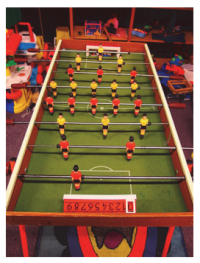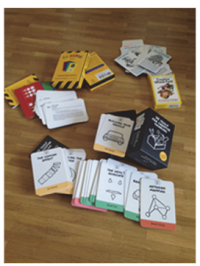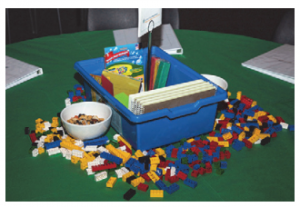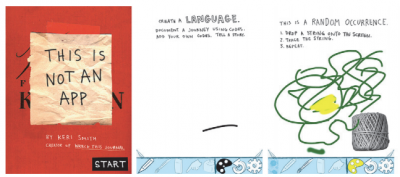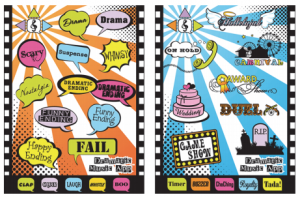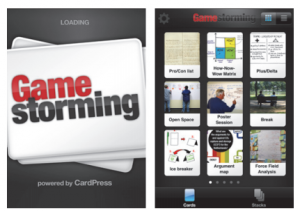The Fun Factor/OG
| The Fun Factor | |
| Contributors | Christian Kohls |
|---|---|
| Last modification | June 6, 2017 |
| Source | Kohls (2016)[1] |
| Pattern formats | OPR Alexandrian |
| Usability | |
| Learning domain | |
| Stakeholders | |
Also Known As: Fun and Playfulness (Fun and Playfulness)
To find new ideas you need to be explorative and playful. But you are trapped with old patterns of thoughts and you don’t know how to escape conventions and how to Challenge Assumptions (Challenge Assumptions).
Your thoughts are constrained by conventions and fear of breaking rules.
Positive feelings make you more creative and productive. Once you relax, you give intuition and Incubation (Incubation) a chance to discover new ideas. You need to be less serious and find yourself in a situation where expectations are turned upside down. How can you stretch your thinking and take things less seriously? You want to find a way to break old settings, put ideas into new contexts, seek ambiguity, connect unrelated concepts, draw new analogies and ask “what if…” questions in thought experiments without losing your face.
Therefore, put yourself and your team into a mood of fun and playfulness. Use humor as a driving tool to alter conventional thoughts and allow concepts that stretch old ideas and get rid of any constraints. A good laugh also makes it easier to point out flaws in existing concepts.
- Create a playful environment to work in. Choose colorful furniture rather than heavy oak tables.
- Equip the rooms with things to play with: Put a bowl of Lego bricks on the table[2], provide card decks as Thought Triggers (Thought Triggers), have some miniature figures around.
- Open creative meetings with small talk that includes jokes. Tell a funny story at the beginning.
- Explicitly discuss what is ridiculous about the current situation, challenge or solution.
- Apply thought provoking rules to the situation. For example, what needs to be done to sell 500% more units in the next quarter? What needs to be done to reduce the size of a smartphone to a matchbox? What would be the consequences?
Humor, creativity, insight, and lateral thinking all have the same basis. They all involve restructuring of patterns and provoke new concepts. Many jokes build up certain expectations and then they surprise the audience with an unexpected alternative interpretation of the story. However, this unexpected development is just another way of putting things together[3].
Think about the ingredients of humor: funny situations are about things that are absurd, they put concepts to the extreme, they exaggerate, improvise, build on the moment of surprise, challenge world views, and get rid of order, rules and assumptions. All the while they make you smile or laugh and put you in a pleasant feeling. Humor helps you to get out of clichés or realize how narrow your previous thoughts were.
- There a several ways to incorporate humor deliberately into creative sessions:
- Just tell a joke. Show a short funny video on YouTube.
- Do something absurd.
- Incorporate improvisation exercises or non-competitive games into longer sessions.
- Use brainstorming games. (See Scannell & Mulvihill[4]; Gray[5]).
- Make a small competition who comes up with the most absurd idea.
New ideas are more likely to come if you play around with existing concepts. As von Oech[6] (p. 108) puts it: “Necessity may be the mother of invention, but play is certainly the father”. Playing means exploring. Deliberately creating absurd situations requires new sense making and guessing about alternative explanations. This a process of defamiliarization where unfamiliar situations, unexpected combination, and novel language lead to an exploration of new territories[7]. Von Oech points out that in a playful environment the “defenses are down”, and we do no longer care for conventional rules – whether they are meaningful or wrong. In plays one can try and test different alternatives without fearing any penalties. Humor works in similar ways as it stretches your thinking, helps to take everything less seriously, and forces the combination of ideas that are usually not connected with each other[6]. While jokes and games get rid of old rules they can deliberately introduce new constraints or assumptions. These new limitations can actually stimulate the creative process since they force you to think into new directions. What if you were only allowed to travel on Wednesdays? What if you were allowed to have only five different products in your product range?
Examples
Digital Tools that are fun
Well, the best and most natural atmosphere is not created by digital tools. Yet, there are some tools that you can use to make things more playful. You can use “comic of the day” websites or show a funny video on YouTube.
References
- ↑ Kohls, C. (2016). Creativity patterns: 5 Habits. In Proceedings of the 10th Travelling Conference on Pattern Languages of Programs (VikingPLoP 2016) (p. 9). New York:ACM.
- ↑ You can use any Lego Bricks. There is also a Lego Serious Play kit that is specially designed for problem solving and creativity sessions.
- ↑ De Bono, E. (1970). Lateral Thinking. London: Penguin Books.
- ↑ Scannell, M., & Mulvihill, M. (2012). The big book of brainstorming games: Quick, effective activities that encourage out-of-thebox thinking, improve collaboration, and spark great ideas!. New York: McGraw-Hill.
- ↑ Gray, D. (2013). Gamestorming. Place of publication not identified: O'Reilly Verlag.
- ↑ 6.0 6.1 von Oech, R. (2008). A whack on the side of the head: How to unlock your mind for innovation. New York, NY: Grand Central Publishing.
- ↑ Gabriel, R. P. (2012). Defamiliarization: Flarf, conceptual writing, and using flawed software tools as creative partners. Knowledge Management & E-Learning: An International Journal (KM&EL), 4(2), 134-145.

